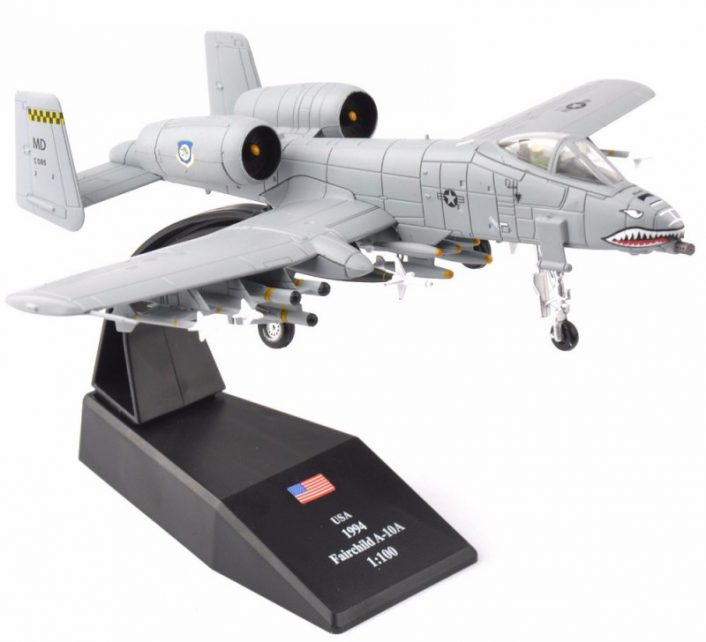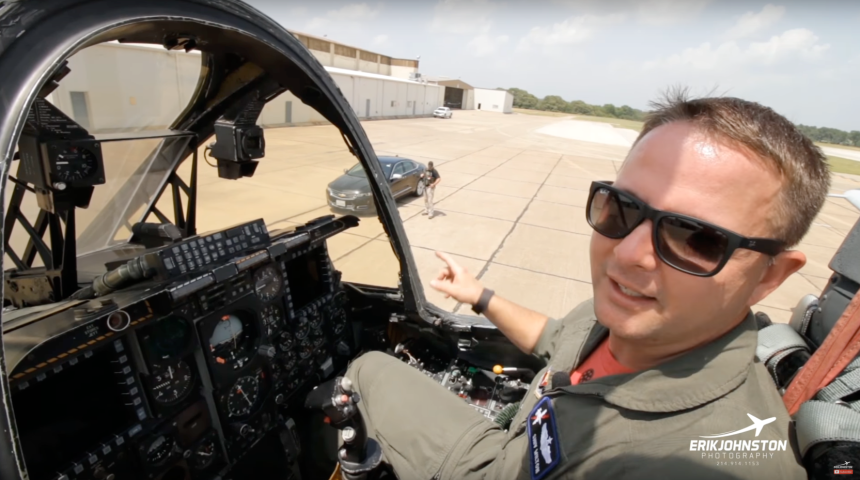Maj. Cody “ShIV” Wilton introduces you to the A-10 Thunderbolt II.
As we first reported last year, the U.S. Air Force A-10C Thunderbolt II demonstration team was assigned a new jet in Sept. 2019, ahead of the 2020 airshow season. The aircraft, serial 80-0275, was repainted by the 355th Equipment Maintenance Squadron at Davis-Monthan Air Force Base, Arizona, and given a paint scheme said to be inspired by P-51 Mustangs and P-47 Thunderbolt during WWII.
Now you can get up close and personal with that very same A-10 (aka “Warthog” or “Hog” or “Hawg”) as Major Cody “ShIV” Wilton, the commander of the A-10 Demo Team, performs a really detailed walkaround of his aircraft in a stunning video filmed by our friend Erik Johnston.
You rarely have a chance to get such a detailed description of all the aircraft parts, systems, sensors. It’s really impressive.
Although there are tons of things I didn’t know about the A-10 before watching this video I found some details about the iconic GAU-8/A Avenger 30mm hydraulically driven seven-
For instance, it’s interesting that the aircraft is equipped with slats that are not slats in the traditional airplane sense as they do not generate lift nor help the pilot land any slower it, but they smooth the airflow off the wing in the engine and prevent stalls when the aircraft flies at high AOA (Angle Of Attack). The slat on each wing also helps diverting the gun gas underneath the wing so it doesn’t suffocate the engine (as the gun gas does not have oxygen) when the aircraft uses the gun. There’s also a wind fence that, when the gun is shooting, diverts the gas down the fuselage. Everything is built around the gun (03:00), even the offset nose landing gear. It’s also interesting to hear about the weight of the 1,150 30-mm rounds of bullets, that equals about 4,000 pounds (each is about three pounds) and the need to consider the weight of the rounds and their shells, that are stored in the drum, to help with the position of the center of gravity of the aircraft. Without the rounds, you would actually have to put ballast in the nose on an empty gun to balance the airplace.
Another interesting thing is the fact (05:06) that the gun is surrounded by titanium, so that if the gun were to blow up it does not penetrate the cockpit that is located just above it.
At 07:18 we learn that there are basically two ways of operating the gun: the training schedule means the gun does not fire more than 100 rounds per minute (so that you can save the life of the barrels), and a combat schedule, when the pilot can shoot at more than 100 round per minute (that will drop the lifespan of the barrels, meaning that they will need to be replaced earlier).
The gun is extremely accurate (07:38): a 5-mil precision means that 80% of rounds will hit within a 5-mil circle with mils being milliradiants (at 1,000 feet five mils would be 5 m hence 80% of rounds would hit within a 5-m circle and that’s a 70 rounds a second!)
The area around the nose features the usual damage around the receptacle where the “boomer” inserts the “flying boom” of the tanker (either a KC-10 or a KC-135). The Warthogs refuel quite frequently both during normal training sorties and when deployed, and the skin in that area is done of sheet metal: the repeated impacts always tear part of the skin creating some pretty evident holes on the upper nose area right before the canopy. However, usually, such dents and damages don’t affect the aircraft’s ability to fly and fight, hence they are left there until the next major maintenance work. “It’s not negatively affecting the characteristics of the airplane at all, the airplane is already draggy enough, this isn’t gonna do anything different ot it.”
Another interesting detail deals with the Thunderbolt II’s main landing gear, whose wheels remain partly exposed. We explained how this feature may become extremly handy during a belly landing because, depending on the stores carried by the aircraft, the wheels that partially protrude from their nacelles can provide a cushion to absorb the impact with the runway while continuing to guarantee the braking action (allowing the pilot to control the aircraft through differential use of the wheel brakes), reduce the risk of fire, and generally speaking, the overall damage to the fuselage. According to “Shiv” the way the MLG was designed means an A-10 that performs a belly landing is able to return to flight in about one week. Not bad.
At 28:00 you can enter the cockpit and seat on the ACES II ejection seat. From there you get a glimpse at the consoles (including U/VHF and FM secure radios, some emergency system, such as the backup speedbrakes and trim actuators), the various buttons of the master arm, gun, laser designator, Targeting Pod; the RWR (Radar Warning Receiver). Dealing with the airspeed indicator it’s interesting to hear that typically and depending on the payload, the A-10 takes off at 135-145 knots, starting rotation to pull the stick 10 knots prior to the calculated rotation speed. Then, gear up, flap up, the A-10 generally climbs at 200 knots. While recovering, the aircraft drops the gear below 200 knots, and landing speed is between 134-135 up to 156 knots (if you are no-flap or one-engine). Then, we get the chance to see the two MFCDs (Multi-Function Color Displays), surrounded by 20 buttons, that can be arranged (37:00) at will to display the map, datalink, weapons status, etc. Noteworthy is also the description of the helmet and cueing integration with other assets via datalink. “The digital upgrades and the weapons upgrades are really amazing stuff that we’ve done”. Indeed, as we have often reported here at The Aviationist, since its introduction in March of 1976, to the 355th Tactical Training Wing, at Davis-Monthan in Arizona, the A-10 has received many upgrades and modernized technology to keep the flying beast airborne. The Precision Engagement Modification Program updated A-10 and OA-10 aircraft to the A-10C with a new flight computer, and new glass displays and controls. Other upgrades included the (JDAM) Joint Direct Attack Munition, and the Remotely Operated Video Enhanced Receiver (ROVER) to provide personnel below, with sensor data. In 2011, the A-10 received a Hand-on-Throttle-and-Stick layout, which combines the F-16’s stick with the F-15’s throttle.
Continuing in the tour, on the bottom right side of the front panel we see the engine and apu gauges. On the right hand console there’s the ECM pod, chaff and flare programming, as well as Master Caution panels and the CDU (Central Data Unit), where all the steering points, nav and target data are stored by means of a card: since it can store about 2,000 waypoints, you need to load the relevant waypoints as part of the mission planning and load those onto the aircraft.
The U.S. Air Force will retire 44 Thunderbolt IIs from its total aircraft inventory, according to the fiscal 2021 Air Force budget documents. These should be the “the oldest and least-ready aircraft” in order to modernize a combat-capable fleet of 218 total A-10s across seven squadrons, Military.com reported.
Meanwhile, the aircraft continue to deploy across the world, supporting U.S. operations in Afghanistan and the Middle East, and take part in U.S. and international exercises. In fact, the U.S. Air Force is slated to operate the type until late 2030s by means of a new major upgrade package part of the A-10 Common Fleet Initiative. The new upgrades come after the completion, at the end of July 2019, of a first re-winging program that saw the installation of new wings, built by Boeing, on 173 A-10s, 162 of which were installed by the 571st Aircraft Maintenance Squadron at the Ogden Air Logistics Complex at Hill Air Force Base and the remaining 11 were re-winged at Osan Air Base in South Korea.
According to the Air Force Materiel Command, the upgraded wings should last for up to 10,000 flight hours without requiring a depot inspection. One month later, the U.S. Air Force awarded Boeing a second contract, worth up to 999M USD, that will provide up to 112 new wing assemblies, completing the re-winging of all the A-10s currently in inventory.










